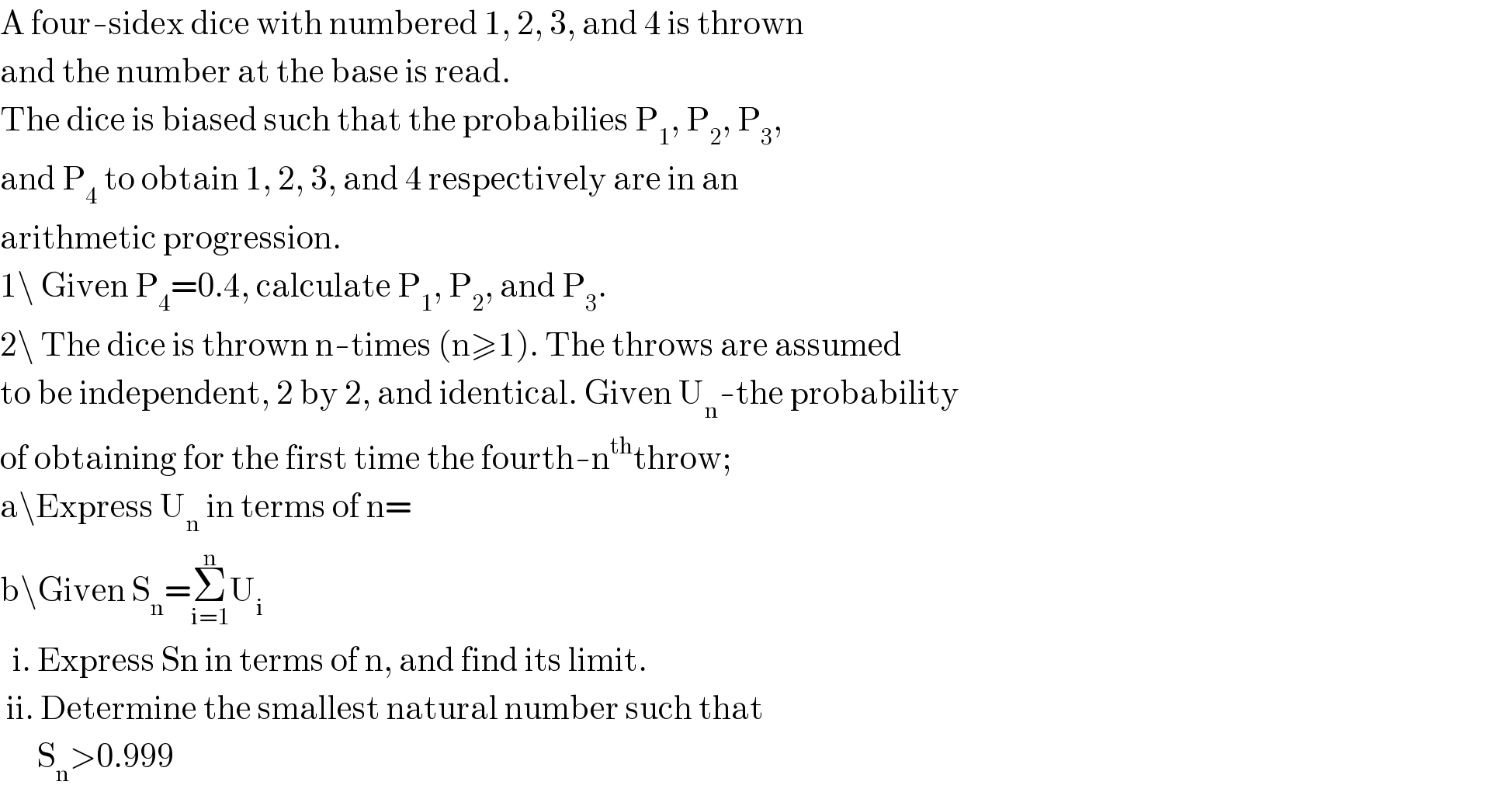
Question Number 102142 by Ar Brandon last updated on 06/Jul/20

$$\mathrm{A}\:\mathrm{four}-\mathrm{sidex}\:\mathrm{dice}\:\mathrm{with}\:\mathrm{numbered}\:\mathrm{1},\:\mathrm{2},\:\mathrm{3},\:\mathrm{and}\:\mathrm{4}\:\mathrm{is}\:\mathrm{thrown} \\ $$$$\mathrm{and}\:\mathrm{the}\:\mathrm{number}\:\mathrm{at}\:\mathrm{the}\:\mathrm{base}\:\mathrm{is}\:\mathrm{read}. \\ $$$$\mathrm{The}\:\mathrm{dice}\:\mathrm{is}\:\mathrm{biased}\:\mathrm{such}\:\mathrm{that}\:\mathrm{the}\:\mathrm{probabilies}\:\mathrm{P}_{\mathrm{1}} ,\:\mathrm{P}_{\mathrm{2}} ,\:\mathrm{P}_{\mathrm{3}} , \\ $$$$\mathrm{and}\:\mathrm{P}_{\mathrm{4}} \:\mathrm{to}\:\mathrm{obtain}\:\mathrm{1},\:\mathrm{2},\:\mathrm{3},\:\mathrm{and}\:\mathrm{4}\:\mathrm{respectively}\:\mathrm{are}\:\mathrm{in}\:\mathrm{an} \\ $$$$\mathrm{arithmetic}\:\mathrm{progression}. \\ $$$$\mathrm{1}\backslash\:\mathrm{Given}\:\mathrm{P}_{\mathrm{4}} =\mathrm{0}.\mathrm{4},\:\mathrm{calculate}\:\mathrm{P}_{\mathrm{1}} ,\:\mathrm{P}_{\mathrm{2}} ,\:\mathrm{and}\:\mathrm{P}_{\mathrm{3}} . \\ $$$$\mathrm{2}\backslash\:\mathrm{The}\:\mathrm{dice}\:\mathrm{is}\:\mathrm{thrown}\:\mathrm{n}-\mathrm{times}\:\left(\mathrm{n}\geqslant\mathrm{1}\right).\:\mathrm{The}\:\mathrm{throws}\:\mathrm{are}\:\mathrm{assumed} \\ $$$$\mathrm{to}\:\mathrm{be}\:\mathrm{independent},\:\mathrm{2}\:\mathrm{by}\:\mathrm{2},\:\mathrm{and}\:\mathrm{identical}.\:\mathrm{Given}\:\mathrm{U}_{\mathrm{n}} -\mathrm{the}\:\mathrm{probability} \\ $$$$\mathrm{of}\:\mathrm{obtaining}\:\mathrm{for}\:\mathrm{the}\:\mathrm{first}\:\mathrm{time}\:\mathrm{the}\:\mathrm{fourth}-\mathrm{n}^{\mathrm{th}} \mathrm{throw}; \\ $$$$\mathrm{a}\backslash\mathrm{Express}\:\mathrm{U}_{\mathrm{n}} \:\mathrm{in}\:\mathrm{terms}\:\mathrm{of}\:\mathrm{n}= \\ $$$$\mathrm{b}\backslash\mathrm{Given}\:\mathrm{S}_{\mathrm{n}} =\underset{\mathrm{i}=\mathrm{1}} {\overset{\mathrm{n}} {\sum}}\mathrm{U}_{\mathrm{i}} \\ $$$$\:\:\mathrm{i}.\:\mathrm{Express}\:\mathrm{Sn}\:\mathrm{in}\:\mathrm{terms}\:\mathrm{of}\:\mathrm{n},\:\mathrm{and}\:\mathrm{find}\:\mathrm{its}\:\mathrm{limit}. \\ $$$$\:\mathrm{ii}.\:\mathrm{Determine}\:\mathrm{the}\:\mathrm{smallest}\:\mathrm{natural}\:\mathrm{number}\:\mathrm{such}\:\mathrm{that} \\ $$$$\:\:\:\:\:\:\mathrm{S}_{\mathrm{n}} >\mathrm{0}.\mathrm{999} \\ $$
